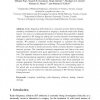Free Online Productivity Tools
i2Speak
i2Symbol
i2OCR
iTex2Img
iWeb2Print
iWeb2Shot
i2Type
iPdf2Split
iPdf2Merge
i2Bopomofo
i2Arabic
i2Style
i2Image
i2PDF
iLatex2Rtf
Sci2ools
ISBMS
2010
Springer
2010
Springer
A Theoretical Model for RF Ablation of Kidney Tissue and Its Experimental Validation
Radio-frequency (RF) ablation is a minimal invasive thermal therapy, currently considered as an alternative to surgery to eradicate small solid kidney tumors. Our aim is to understand the kinetics of thermal lesion growth in kidney tissue exposed to RF energy by taking into account dynamic time-temperature changes in electrical properties of multiple tissues (i.e. kidney, surrounding fat, muscle). We present a computer model designed to calculate the voltage distribution and the temperature rise in kidney. The model further calculates the RF lesion size based on kinetic processes, which correctly describe coagulative necrosis process. The simulated transient temperatures and lesion size were experimentally validated with good agreement in a porcine kidney model, ex vivo. The expected increase in electrical conductivity of kidney (approximately 3 times) during heating resulted in predicted lesion width and depth that were larger (by as much as 20% and 30% respectively) than those predic...
| Added | 09 Jul 2010 |
| Updated | 09 Jul 2010 |
| Type | Conference |
| Year | 2010 |
| Where | ISBMS |
| Authors | Mihaela Pop, Sean R. H. Davidson, Mark Gertner, Michael A. S. Jewett, Michael D. Sherar, Michael C. Kolios |
Comments (0)

